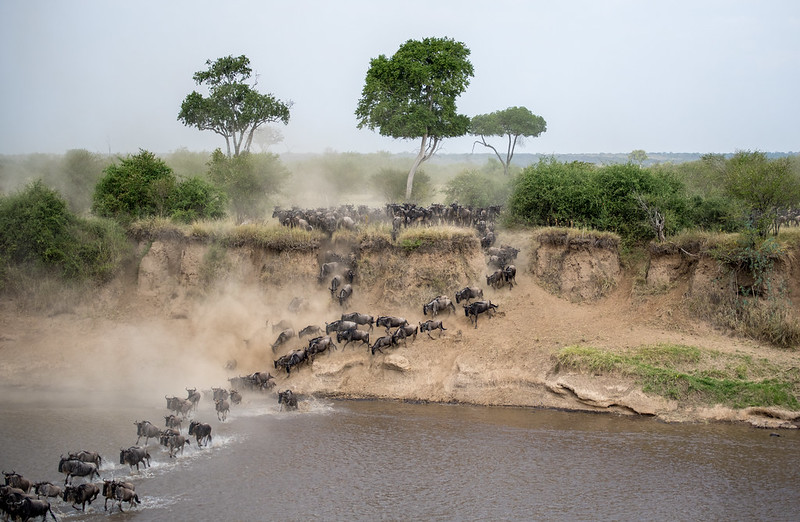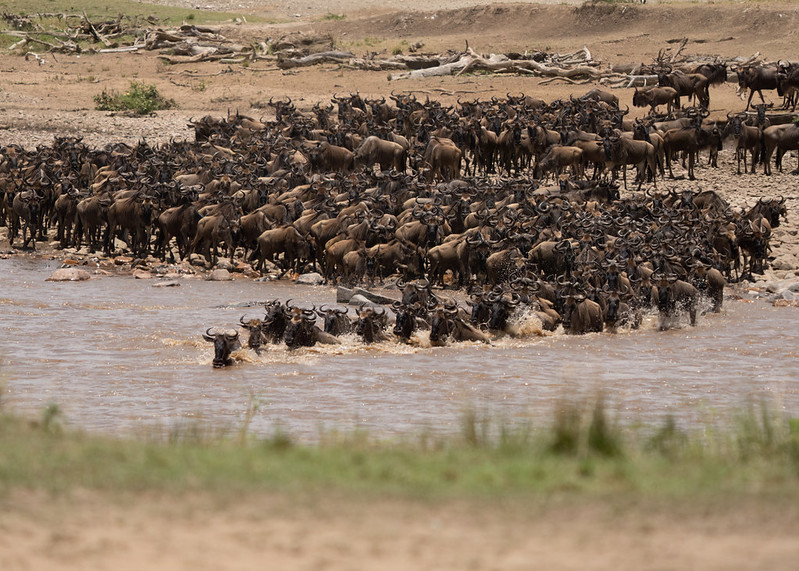The Wildebeests start arriving Kenya in June and by July- August, the entire plains of Mara have been occupied by the wildebeests, zebras and gazelles and its when mara crossing is in progress
Wildebeests Migration In Masai Mara
Overview
The Great Wildebeest Migration, often considered one of the most spectacular natural events in the world, is an annual migration of wildebeests (also known as gnus) along with zebras, gazelles, and other ungulates in East Africa, specifically in the Serengeti ecosystem of Tanzania and the Maasai Mara ecosystem of Kenya.
The migration is a circular movement covering approximately 1,800 miles (2,900 km). It involves wildebeests, zebras, gazelles, and other herbivores moving from the Serengeti National Park in Tanzania to the Maasai Mara National Reserve in Kenya and back. The migration typically occurs from July to October, with exact timing depending on the weather and rainfall patterns.

Related Kenya Safaris
What To Know
Reasons why the Wildebeests Migrate:
The primary reasons for the migration are to follow the availability of food and water. Wildebeests migrate in search of fresh grazing pastures and water sources to sustain themselves and their young. The movement is also linked to the calving season, with wildebeests seeking safety and abundant food for their calves.
Calving Season:
The migration coincides with the wildebeests’ calving season, usually between January and March. During this time, the herds gather in the southern Serengeti to give birth to their young. The abundance of nutrient-rich grasses in the region provides ideal conditions for the survival of the newborn calves.

All you need to know about the Wildebeests Migration
Serengeti Phase:
The migration starts in the southern Serengeti during the rainy season (usually November to May), where wildebeests and other animals gather to graze on the lush, green grasses. As the dry season approaches, they start moving northwest, facing numerous challenges including river crossings and encounters with predators like lions and crocodiles.
River Crossings:
River crossings are one of the most iconic and dramatic aspects of the wildebeest migration. The Mara River, which separates Tanzania and Kenya, is a major obstacle. Thousands of wildebeests attempt dangerous river crossings, facing the threat of crocodiles and drowning.
Maasai Mara Phase:
The migration reaches the Maasai Mara in Kenya around July. The herds graze here until October, when they start their return journey to the Serengeti. The Maasai Mara provides rich grasslands and an abundance of water, making it a critical part of the migration cycle.
Predator Interaction:
The migration attracts a large number of predators, including lions, leopards, cheetahs, and hyenas, which follow the herds to hunt for prey, especially the young, weak, or injured animals.
Conservation and Tourism:
The Great Wildebeest Migration is a major tourist attraction, drawing visitors from around the world. It also highlights the importance of conservation efforts to protect the fragile ecosystem and ensure the survival of these magnificent creatures and their habitats.
In summary, the Great Wildebeest Migration is a natural phenomenon driven by the need for food, water, and safety. It’s a spectacular display of animal movement and survival, illustrating the intricate balance of nature in East Africa’s Serengeti and Maasai Mara ecosystems.
Best Time To Visit
- When is the Wildebeest Migration in Kenya?
The Wildebeests start arriving Kenya in June and by July- August, the entire plains of Mara have been occupied by the wildebeests, zebras and gazelles filling up the entire Mara plains to the horizon as well as on top of the hills its such as great and spectacular sightings. - Best time to see the Migration in Kenya
The best time to catch up with the wildebeests in Kenya is during mid-July to August when lots of the animals have finally crossed over from the Serengeti plains in to Masai mara. During this time, you will witness thousands of animals infested across the Mara plains.
How to get there
The Epic River Crossing: The Mara River crossing is a remarkable natural event that occurs in the Maasai Mara National Reserve in Kenya and the Serengeti National Park in Tanzania. It is an extraordinary spectacle where wildebeest and other herbivores migrate across the Mara River in search of greener pastures.The migration, often referred to as the Great Wildebeest Migration, is one of the most significant wildlife events in Africa. It involves millions of wildebeest, zebras, gazelles, and other herbivores moving across the savannas in search of food and water. This migration is driven by seasonal changes and the availability of resources.
The Mara River crossing is a crucial part of the migration, especially for the wildebeest. It’s a perilous journey, as the river is infested with crocodiles and can be treacherous due to strong currents and steep banks. Wildebeest gather in large numbers on the riverbanks, hesitating and waiting for the bravest or most desperate individuals to make the initial leap into the river. Once one wildebeest makes the move, others follow, creating a chaotic and dramatic scene.
The crossing is both a breathtaking natural phenomenon and a matter of life and death for the animals involved. It’s a test of survival as the wildebeest face the dangers of the river while trying to evade the lurking crocodiles. The crossing attracts tourists and photographers from all over the world who come to witness and capture this awe-inspiring event.
If you’re planning to witness the Mara River crossing, it’s important to coordinate with local guides and tour operators for the best timing and locations, as the migration patterns can vary from year to year based on weather conditions and other factors.
Request Quote
Fill in and send the safari request form, we shall respond as soon as we receive your message.
You can also reach us on Whats-app Number: +256753750983 for urgent requests.
Tour Highlights
- Day 1: Transferring from Nairobi to the Lake Nakuru
- Day 2: Lake Nakuru to Masai Mara National Reserve
- Day 3: A Full day in the Masai Mara
- Day 4: Transfer back to Nairobi
Why Book This Tour?
- Tour can depart on any day of the week.
- Tour can be customized
- Transportation in Landcruiser or minivan with pop-up for game viewing
- Suitable for solo travelers
Kenya National Parks
Masai Mara National Reserve
Read Our Reviews





